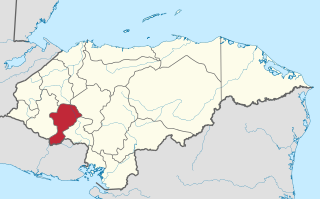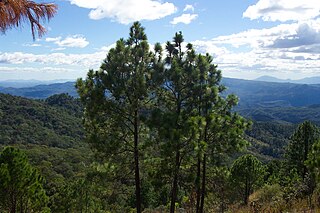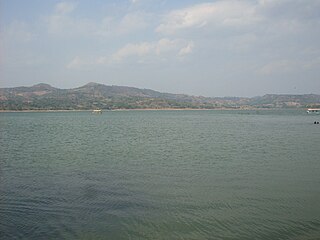
El Salvador, officially the Republic of El Salvador, is a country in Central America. It is bordered on the northeast by Honduras, on the northwest by Guatemala, and on the south by the Pacific Ocean. El Salvador's capital and largest city is San Salvador. The country's population in 2023 was estimated to be 6.5 million.

El Salvador is a country in Central America. Situated at the meeting point of three tectonic plates, it is highly seismologically active and the location of numerous earthquakes and volcanic eruptions. The country has a tropical climate.

San Salvador is the capital and the largest city of El Salvador and its eponymous department. It is the country's political, cultural, educational and financial center. The Municipality of San Salvador has 209,633 inhabitants (2020). The Metropolitan Area of San Salvador, which comprises the capital itself and 13 of its municipalities, has a population of 2,404,097. The urban area of San Salvador has a population of 1,600,000 inhabitants.

Santa Ana is the second largest city in El Salvador, after the capital of San Salvador. It is located 64 kilometers northwest of San Salvador, the capital city. Santa Ana has approximately 374,830 (2017)) inhabitants and serves both as the capital of the department of Santa Ana and as the municipal seat for the surrounding municipality of the same name. For its administration the municipality is divided into 35 colonias (neighborhoods) and 318 small villages.

Intibucá is one of the 18 departments in the Republic of Honduras. Intibucá covers a total surface area of 1,186.1 square miles (3,072 km2). Its capital is the city of La Esperanza, in the municipality of La Esperanza.

Jujuy is a province of Argentina, located in the extreme northwest of the country, at the borders with Chile and Bolivia. The only neighboring Argentine province is Salta to the east and south.

Morazán is a department of El Salvador. Located in the northeast part of the country, its capital is San Francisco Gotera. It covers a total surface area of 1,447 km2 and has a population of more than 199,500.

Torola is a municipality in the Morazán department of El Salvador.

Osicala is a city in the Department of Morazan, Republic of El Salvador. It is 184 km (114 mi) from the capital, San Salvador, on one of the hills north of Cerro Cacahuatique. It borders Meanguera to the north, southeast with Delicias de Concepción, and west with Gualococti. Its climate, due to its elevation, has moderate temperatures most of the year.

Presidential elections were held in El Salvador on 15 March 2009. The main candidates were Rodrigo Ávila (ARENA) and Mauricio Funes (FMLN). Funes won the election with 51.3% of the vote and became the first leftist president of El Salvador.

Prodetur is an ecotourism organization, directed and managed by Luis Diaz Martinez, and is headquartered in the village of Perquin in the Morazán Province of El Salvador. Prodetur directs tourist activities in Morazán which ensure the continuity of the Rio Sapo preservation initiative.

The Lempa River is a 422-kilometre-long (262 mi) river in Central America.
Water resources management in El Salvador is characterized by difficulties in addressing severe water pollution throughout much of the country's surface waters due to untreated discharges of agricultural, domestic and industrial run off. The river that drains the capital city of San Salvador is considered to be polluted beyond the capability of most treatment procedures.
Juan Isolino Rosa, was a Salvadoran composer, music professor, and folklorist. He founded the Escuela Normal de Suchitoto and became the director of more than twenty institutions throughout El Salvador. He was honored by the government of El Salvador in 1976 at the National Gymnasium with the "Medalla de Oro" and "Diploma de Honor". The composer of numerous waltzes and children's songs, one of his best known compositions is "Torola". He was involved with numerous music festivals in the country and was a promoter of Salvadoran culture.

Tourism accounts for a large part of El Salvador's economy. El Salvador has many natural attractions including beaches with some of the best surfing breaks on the Pacific Coast. El Salvador offers many lush forests shrouded in cool temperatures with abundant wildlife and scenic mountain-top vistas. El Salvador also has great potential in the field of cultural tourism; with over 2,000 known archaeological sites, mostly of the Maya and Olmec cultures. These sites are of international interest for their easy access and well-preserved remains.
María Ofelia Navarrete is a Salvadoran politician and ex-combatant. She was appointed to the position of Minister of Local Development by President Nayib Bukele in May 2019.

The Cerrón Grande Reservoir, also known locally as Lake Suchitlán, is a reservoir in northern El Salvador and the largest body of fresh water in the country. The reservoir was filled between 1973 and 1976, subsequent to the construction of the Cerrón Grande Hydroelectric Dam. The Cerrón Grande Reservoir is among the most polluted bodies of fresh water in Central America.















